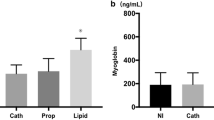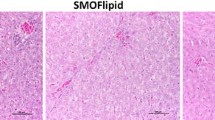Abstract
Background
Free radical-induced lipid peroxidation associated with a decrease of antioxidant capacity in plasma is observed after the deflation of the pneumoperitoneum in laparoscopic surgery. In this study, we evaluated the effect of the continuous administration of lipid peroxidation derivatives on emulsified propofol.
Methods
Two groups of 20 patients each who underwent laparoscopic surgery were studied prospectively. Maintenance of anesthesia was achieved with 66% nitrous oxide and either isoflurane or continuous propofol administration. The level of thiobarbituric acid-reactive substances (TBARS) in the plasma was determined as a measure of free radicals before and after surgery.
Results
Ten patients in the propofol group had reduced TBARS, as compared to only one in the isoflurane group (p =0.003). There was a statistically significant difference in age between the patients with reduced TBARS and those without reduced TBARS (p=0.009) in the propofol group.
Conclusions
Anesthesia with continuous propofol infusion in laparoscopic surgery has a significant scavenging action on the formation of free radicals and exerts its greatest antioxidant effect in patients ≥48 years of age.
Similar content being viewed by others
References
Aarts L, Van der Hee R, Dekker I, Langemeijer H, Bast A (1995) The widely used anesthetic agent propofol can replace alphatocopherol as an antioxidant. FEBS Lett 357: 83–85
Bennett S, Nelson V, Green T (1993) Propofol (2,6 diisopropylphenol) as an antioxidant in-vitro: a dose response study. Br J Anaesth 70 (Suppl 1): 78 A152 (Abstract)
Cernak I, Savic V, Kotur J, Prokic V, Kuljic B, Grbovic D, Veljovic M (2000) Alterations in magnesium and oxidative status during chronic emotional stress. Magnes Res 13: 29–36
Eleftheriadis E, Kotzampassi K, Papanotas K, Heliadis N, Sarris K (1996) Gut ischaemia, oxidative stress and bacterial translocation in elevated abdominal pressure in rats. World J Surg 20: 11–16
Eleftheriadis E, Kotzampassi K, Tzartinoglou E, Farmakis H, Dadoukis J (1996) Splanchnic ischaemia during laparoscopic cholecystectomy. Surg Endosc 10: 324–326
Glantzounis G, Tselepis A, Tambaki A, Trikalinos T, Manataki AD, Galaris D, Tsimoyiannis EC, Kappas A (2000) Laparoscopic surgery-induced changes in oxidative stress markers in human plasma. Surg Endosc: (in press)
Green TR, Bennett SR, Nelson VM (1994) Specificity and properties of propofol as an antioxidant free radical scavenger. Toxicol Appl Pharmacol 129: 163–169
Hans P, Deby-Dupont G, Deby C, Pieron F, Verbesselt R, Franssen C, Lamy M (1997) Increase in antioxidant capacity of plasma during propofol anesthesia. J Neurosurg Anaesthesiol 9: 234–236
Hans P, Deby C, Deby-Dypont G, Vrijens B, Albert A, Lamy M (1996) Effect of propofol on in vitro lipid peroxidation induced by different free radical generating systems: a comparison with vitamin E. J Neurosurg Anaesthesiol 8: 154–158
Jakimowicz J, Stultiens G, Smulders F (1998) Laparoscopic insufflation of the abdomen reduces portal venous flow. Surg Endosc 12: 129–132
Johnson ME, Fauq AH, Uhl CB (1966) The effect of propofol and propofol quinone on hydroxyl radical generation. Anesth Analg 82(2S): S206
Kahraman S, Demiryuerek AT (1997) Propofol is a peroxynitrite scavenger. Anesth Analg 84: 1127–1129
Kahraman S, Kilinc K, Dal D, Erdemi K (1997) Propofol attenuates formation of lipid peroxides in tourniquet-induced ischaemia-reperfusion injury. Br J Anaesth 78: 279–281
Kazama T, Takeuchi K, Ikeda K, Ikeda T, Kikura M, Iida T, Suzuki S, Hanai H, Sato S (2000) Optimal propofol plasma concentration during upper gastrointestinal endoscopy in young, middle-aged, and elderly patients. Anesthesiology 93: 662–669
Miquel J, Ramirez-Bosca A, Soler A, Diez A, Carrion-Gutierrez MA, Diaz-Alperi J, Quintanilla-Ripoll E, Bernd A, Quintanilla-Almagro E (1998) Increase with age of serum lipid peroxides: implications for the prevention of atherosclerosis. Mech Ageing Dev 100: 17–24
Murphy PG, Atkinson R, Columb MO, Myers DS, Day P (1992) Effect of propofol and thiopentone on free radical-induced haemolysis. Br J Anaesth 69: 532P-533P
Murphy PG, Bennett JR, Myers DS, Davies MJ, Jones JG (1992) Effect of anaesthetic doses of propofol on liver cell membrane lipid peroxidation in the rat. Br J Anaesth 68: 439P
Murphy PG, Bennett JR, Myers DS, Davies MJ, Jones JG (1993) The effect of propofol anaesthesia on free radical-induced lipid peroxidation in rat liver microsomes. Eur J Anaesteriol 10: 261–266
Murphy PG, Davies MJ, Columb MO, Stratford N (1996) Effect of propofol and thiopentone on free radical mediated oxidative stress of the erythrocyte. Br J Anaesth 76: 536–543
Murphy PG, Myers DS, Davies MJ, Webster NR, Jones JG (1992) The antioxidant potential of propofol (2,6-diisopropylphenol). Br J Anaesth 68: 613–618
Nelson VM, Bennett S, Green TR (1993) The nature of free radical with which 2,6-diisopropylphenol interacts. Br J Anaesth 71: 313P
Ohkawa H, Ohishi N, Yagi M (1979) Assay for lipid peroxides in animal tissues by thiobarbituric acid reaction. Anal Biochem 95: 351–358
Okutomi T, Saito M, Hoka S (1998) The effect of propofol, emulsified propofol (‘Diprivan’) and emulsifier (intralipid) on hydroxyl radical generated by Fenton reaction. Anesth Analg 86 (Suppl): S493
Olmos M, Ballester JA, Vidarte MA, Elizalde JL, Escobar A (2000) The combined effect of age and premedication on the propofol requirements for induction by target-controlled infusion. Anesth Analg 90: 1157–1161
Urano S, Sato Y, Otonari T, Makabe S, Suzuki S, Ogata M, Endo T (1998) Aging and oxidative stress in neurodegeneration. Biofactors 7: 103–112
Windsor MA, Bonham MJ, Rumball M (1997) Splanchnic mucosal ischaemia: an unrecognised consequence of routine pneumoperitoneum. Surg Laparosc Endosc 7: 480–482
Author information
Authors and Affiliations
Additional information
Online publication: 12 June 2001
Rights and permissions
About this article
Cite this article
Manataki, A.D., Tselepis, A.D., Glantzounis, G.K. et al. Lipid peroxidation and the use of emulsified propofol in laparoscopic surgery. Surg Endosc 15, 950–953 (2001). https://doi.org/10.1007/s004640090104
Received:
Accepted:
Issue Date:
DOI: https://doi.org/10.1007/s004640090104




